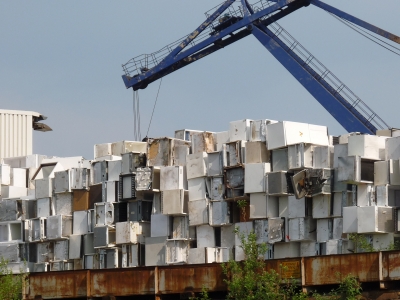The quantity of climatically harmful CFCs contained in these appliances is not a problem provided they are treated so that these environmentally toxic substances are removed in a systematic and transparent manner that meets stringent environmental quality standards. CFCs are not only hazardous for the integrity of the Earth’s ozone layer they also have a global warming potential many times greater than that of carbon dioxide. Preventing the emission of CFCs through the proper demanufacturing of end-of-life appliances offers an effective CO2 diet plan for our planet.
The facts couldn’t be clearer. According to experts in the field, there are still some 25 million CFC-containing and HFC-containing refrigeration appliances in use in the more than 200 million domestic households within the European Union. Failure to recover the refrigerants and blowing agents in these waste refrigeration appliances would result in their release into the environment, which would be equivalent to emitting more than 60 million tons of carbon dioxide into the Earth’s atmosphere. To understand what this number means it is worth realizing that in Germany annual carbon emissions from the entire traffic sector are 160 million tons. This comparison shows the necessity of treating end-of-life refrigeration appliances in accordance with the most stringent environmental standards.
Standardization institutions like RAL and DIN have provided the recycling industry with key regulatory frameworks. The European Norm EN 50574:2012 and the associated Technical Specification TS EN50574-2:2014 have been published as standards that govern the environmentally correct treatment of waste refrigeration equipment. These standards also cover the treatment of appliances manufactured after the Montreal CFC ban. These latter appliances were manufactured with chlorine- and fluorine-free hydrocarbons, such as R600a (as a replacement refrigerant in the cooling circuit) and pentane (as a substitute blowing agent in the insulating materials). The WEEE Directive and the corresponding national implementing laws require the removal and subsequent collection of refrigerants and blowing agents, the EN standard and its accompanying Technical Specification specify the quantities of refrigerants and blowing agents to be recovered by treatment facilities, irrespective of whether these are CFCs or the more environmentally benign hydrocarbons (HCs).
In order to minimize the carbon footprint from the treatment of end-of-life refrigeration equipment, it is essential that CFC-containing and hydrocarbon-containing appliances are treated jointly in the same demanufacturing facility. Specialist recycling companies are not only able to completely remove all CFCs and HCs from the waste appliances, they are also able to recover in pure form the other materials used in the production of the appliances, such as steel, copper, aluminium and plastics. The reintroduction of these secondary raw materials into the production cycle not only helps to conserve resources, it also contributes to improving the carbon emissions balance sheet of the fridge demanufacturing process, as the reuse of these materials is associated with lower carbon emission levels when compared with new production using virgin raw materials.
The majority of experts working in the field of fridge re-cycling favour the joint processing of CFC-containing and HC-containing appliances as this approach eliminates the chance of contaminating HC processing streams with incorrectly sorted appliances containing CFCs or HFCs. It is for this reason that experts argue strongly against attempting to treat CFC/HFC-appliances and HC-appliances in separate processing streams and, most especially, against processing HC-appliances in an open shredder. Joint processing also makes a positive contribution to the overall carbon emissions balance sheet.
The RAL GZ 728 Quality Assurance and Test Specifications, which were first published by RAL – the German Institute for Quality Assurance and Certification [Deutsches Institut für Gütesicherung und Kennzeichnung e.V.] – and last revised in 2012, combines the requirements set out in EN 50574:2012/TS EN 50573-2:2014 with a means of quantitatively assessing and visualizing the carbon emission savings achieved by a treatment facility. The RAL Quality Assurance Association for the Demanufacture of Refrigeration Equipment has introduced the RAL CO2OL-PRINT tool as an optional element in its quality assurance scheme. The key aim of this new tool is to quantify the carbon emissions actually saved by the daily operations of a specific treatment facility. This involves continuously monitoring and measuring the masses of CFCs and HCs actually removed from the cooling circuits and insulation materials of the waste appliances and then translating these figures into CO2 equivalents. The same approach is taken for the metals and plastics also recovered during the treatment process. The carbon emissions associated with the energy consumed when transporting and treating the end-of-life appliances must, of course, also be taken into account. The RAL Quality Assurance Association then combines all of the data into an overall carbon emissions balance sheet that is made available to the demanufacturing facility in the form of a certificate issued monthly or every three or six months.
The RAL CO2OL-PRINT tool thus improves process transparency and helps stakeholders to visualize the significant contribution that fridge demanufacturing makes to achieving climate protection goals. Professional fridge demanufacturing is therefore a major contributor to lowering carbon emissions and meeting the objectives of our planet’s CO2 diet plan.







